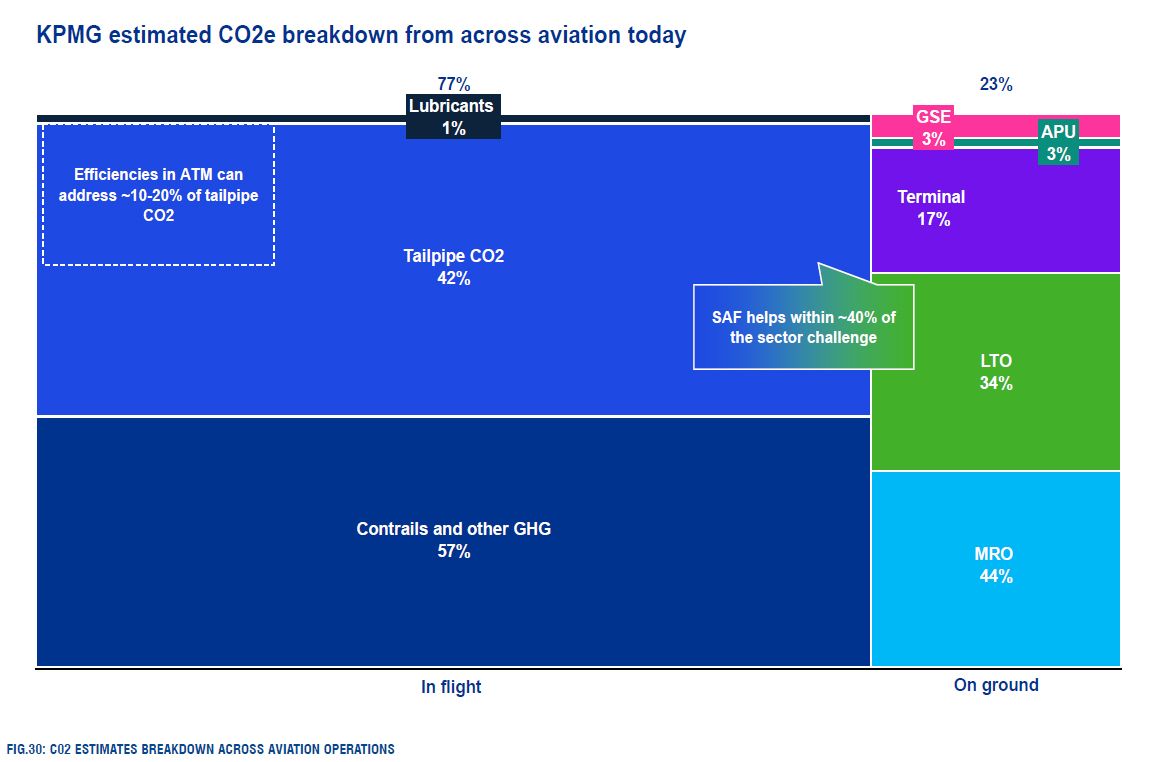With net zero by 2050 now an established objective for the sector, aviation faces a huge challenge to decarbonise. Chris Brown of our Strategy team explains the issues and implications.
Whilst hydrogen, hybrid and electric models offer potential in some market segments, they are only likely to become widespread in the global fleet into the 2050s. In the meantime, sustainable aviation fuel (SAF) offers substantial mitigation potential as a drop-in fuel that can be blended with conventional Jet A-1. However, SAF supplies of all types remain well below industry needs, and today’s most prevalent SAF type (i.e. biofuels) faces real scalability challenges, stemming mainly from supply chain bottlenecks and doubts over feedstock sustainability.
With these barriers in mind, our view is that power to liquid (PtL) synthetic fuel, obtained from lowcarbon hydrogen and CO2, represents the most scalable SAF product for long-term use. However, its potential won’t be achieved without major investment in electrolysis and carbon capture technology.
SAF demand and supply
While SAF is very similar to conventional jet fuel, it delivers substantially lower greenhouse gas emissions (GHG) – typically by around 80%.
Voluntary demand for SAF from airlines is growing rapidly and is set to escalate during the 2020s. European regulators have already announced rising SAF requirements, whilst the US has set a SAF production target of at least 3 billion gallons per year by 2030, with California mandating that SAF should comprise 20 percent of aviation fuel consumed in the state by 2030.
At present, the dominant SAF type is synthesised paraffinic kerosene from hydroprocessed esters and fatty acids (HEFA). Whilst HEFA is the simplest and cheapest form of SAF, its availability will be limited by overall feedstock supply and price volatility, especially as it continues to be used in road and maritime fuel. Many HEFA feedstocks are monocrops, reliant on fertilisers, linked to biodiversity reduction, and vulnerable to climatic and geopolitical price shocks – as the invasion of Ukraine has thrown into sharp relief.
As we approach 2030, we expect to see a surge in the supply of fuel made from alternative biogenic and nonbiogenic waste feedstocks, including agricultural residues, used tyres and municipal solid waste (MSW). However, feedstock constraints are once again a risk as these waste streams are sought by other sectors, such as incineration and bioenergy with carbon capture and storage (CCS), putting them in direct competition. As a consequence, the total SAF yield globally is likely to remain relatively limited, especially in the coming decade, and there remains a significant risk that SAF production levels will prove unable to meet current expectations.


The synthetic opportunity
Of the SAF types on offer, it is our view that e-fuel, or PtL offers the greatest opportunity for decarbonisation at the scale the aviation sector requires.
E-fuels are produced using low-carbon hydrogen (produced from biogas or renewable / nuclear electricity electrolysis) and captured CO2. Their supply potential is far higher than other SAF types, and their lifecycle carbon savings relative to fossil Jet A1 can be over 90%. However, they are highly energy-intensive to produce, and will require major expansion of both hydrogen electrolysis and direct air capture (DAC) capacity to provide the necessary volumes of CO2 feedstock. Given the sizable risks involved, such expansion will need to happen via industry collaborations across the supply chain, supported by governments.
Cost competitiveness
Future cost competitiveness of SAF with Jet A-1 depends heavily on government regulation pricing CO2 emissions appropriately. While it remains cheaper for airlines to offset carbon emissions through trading schemes than by replacing Jet A-1 with SAF, we do not expect SAF supply to meaningfully exceed government-mandated levels. Our modelling suggests that such a pivot point may not be reached before 2040 at the current projected rate of carbon price increase.
This length of this time horizon raises important questions about the shape of the future regulatory landscape. We expect the regulatory approach to aviation emissions to evolve significantly over the coming decade, and today’s focus on SAF is likely to be joined by new priorities and approaches as decarbonisation strategies are fleshed out. Direct carbon emissions will be eclipsed by total sector CO2 equivalent (CO2e) as the primary concern for regulators, expanding attention to contrails management, alongside the focus on ever-higher SAF blends.
Conclusions
At present we are seeing a race by airlines to secure access to HEFA supplies, both to meet immediate voluntary demand and as a natural hedge against expected supply mandates from 2025 onwards. However, given the real constraints to HEFA production expansion, we believe PtL will be pivotal to the achievement of aviation’s long-term SAF usage goals. Investors will need to consider this long-term technology outlook alongside promoting sustainable, short-term HEFA supply.
Get in touch
If you have any queries on the future of sustainable aviation fuel, please contact Chris Brown of our Strategy team. We'd be delighted to hear from you.
Christopher Brown
Partner, Head of Strategy
KPMG in Ireland



